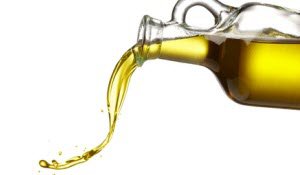
With the large array of cooking oil choices at the supermarket, it’s easy to get overwhelmed. Here’s a guide for choosing healthful oils, plus which oils you should always have on hand.
Choosing Healthy Fats
First, a bit about fats: All food sources that we think of as “fats”–we’re talking butter, shortening, and oils–are made up of fatty acids. These fatty acids have specific chemical shapes that affect both how the fat performs in cooking (or baking) and how the fat affects your health. These chemical shapes are generally classified as saturated, polyunsaturated, or monounsaturated. All fats contain all three types but are classified by the type of fatty acid that makes up most of the fat. For example, since butter consists mostly of “saturated” fatty acids, it’s considered a “saturated fat.”
Saturated Fats
A diet high in saturated fat has been linked with elevated cholesterol levels and increased risk for heart disease, so it’s best to limit your use.
Examples: Butter, lard, shortening.
How to Spot Them: They’re solid at room temperature.
Polyunsaturated Fats
When used in place of saturated fats, polyunsaturated fats can help to improve blood cholesterol levels, thereby reducing risk for heart disease. Omega-6 and omega-3 describe specific types of polyunsaturated oils. Although both omega-6 and omega-3 fats are essential for good health, omega-3s also have additional heart-health and anti-inflammatory benefits.
Examples: Canola oil, sunflower oil, walnut oil.
How to Spot Them: They’re always liquid, even if you put them in the fridge.
Monounsaturated Fats
When substituted for saturated fats, monounsaturated fats can help to improve blood cholesterol levels, thereby reducing risk for heart disease. In short, you should choose polyunsaturated and monounsaturated fats–olive and canola oils, for instance–over saturated fats, like butter and lard, to minimize your risk for heart disease. And a well-stocked kitchen includes a variety of different oils for a variety of reasons: what you’re using them for, their nutritional benefits, and how much they cost.
Examples: olive oil, peanut oil
How to Spot Them: They’re liquid at room temperature but become semisolid (or cloudy) in the refrigerator.
Our Top 3 Oil Picks
If you have limited pantry space and a limited budget, these three oils will cover your basic cooking and baking needs.
Extra-Virgin Olive Oil
In addition to being a source of monounsaturated fats, extra-virgin olive oil is also high in antioxidants called polyphenols that have been linked to heart health. (“Pure” olive oil–in other words, not virgin–doesn’t contain these “bonus” antioxidants.)
Best uses: Use in dishes that will benefit from olive oil’s rich flavor–drizzle on steamed vegetables and use to make salad dressing or to sauté vegetables.
Monounsaturated: 78% | Polyunsaturated: 8% | Saturated: 14%
Canola Oil
Its neutral flavor and high smoke point makes this oil an excellent choice for baking and sautéing. Most canola oil is highly refined–which means that it doesn’t have many antioxidants like olive oil does but it does have a relatively long shelf life.
Monounsaturated: 62% | Polyunsaturated: 31% | Saturated: 7%
Best Uses: Because it’s extremely versatile, you can use canola oil for sautéing, roasting, baking, and making salad dressings. If you want to enjoy the heart-healthy benefits of olive oil but find its flavor too strong, try using a 1:1 ratio of canola and extra-virgin olive oil when making salad dressing.
Walnut Oil
This specialty oil sports a higher price tag, but along with that comes a rich, nutty flavor and omega-3s. Walnut oil–as with all nut oils–has a short shelf life. Buy a small bottle and store it in your refrigerator for up to three months.
Monounsaturated: 24% | Polyunsaturated: 67% | Saturated: 9%
Best Uses: Its nutty flavor doesn’t work in every dish but it’s delicious in salad dressings (try a blend of canola and walnut oils) or baked goods that would benefit from a light walnut flavor.
Three More Oils to Try
In addition to extra-virgin olive oil, canola oil, and walnut oil, here are three more healthy cooking oils to try.
Grapeseed Oil
Extracted from grape seeds, this versatile oil is usually mild in flavor, but imported ones may have a grapy flavor and aroma. A good choice for cooking over high heat.
Monounsaturated: 17% | Polyunsaturated: 73% | Saturated: 10%
Best Uses: Use this all-purpose oil for sautéing, roasting and in salad dressings.
Peanut Oil
The high smoke point of peanut oil makes it a good choice for cooking over high heat. It contains heart-healthy phytosterols, essential plant fats known to lower cholesterol and inhibit cancer.
Monounsaturated: 48% | Polyunsaturated: 34% | Saturated: 18%
Best Uses: Roasting and sautéing.
Sesame Oil
Essential to Asian cooking, sesame oil has a rich, nutty flavor. You’ll often find untoasted and toasted versions with other Asian ingredients in your supermarket.
Monounsaturated: 41% | Polyunsaturated: 44% | Saturated: 15%
Best Uses: Stir-fry with untoasted sesame oil; drizzle toasted sesame oil onto a finished dish to give it a toasty flavor and aroma or use in salad dressing.
The One Medical blog is published by One Medical, a national, modern primary care practice pairing 24/7 virtual care services with inviting and convenient in-person care at over 100 locations across the U.S. One Medical is on a mission to transform health care for all through a human-centered, technology-powered approach to caring for people at every stage of life.
Any general advice posted on our blog, website, or app is for informational purposes only and is not intended to replace or substitute for any medical or other advice. 1Life Healthcare, Inc. and the One Medical entities make no representations or warranties and expressly disclaim any and all liability concerning any treatment, action by, or effect on any person following the general information offered or provided within or through the blog, website, or app. If you have specific concerns or a situation arises in which you require medical advice, you should consult with an appropriately trained and qualified medical services provider.